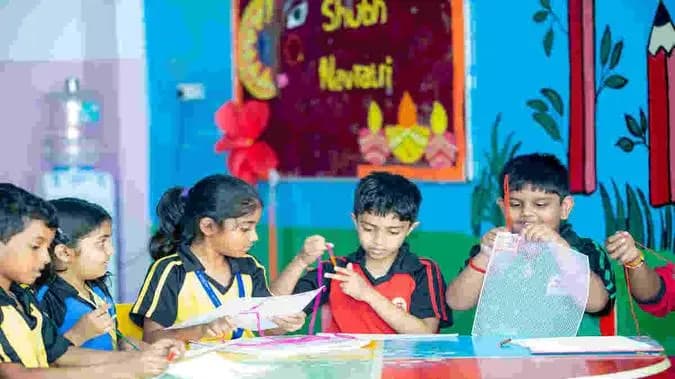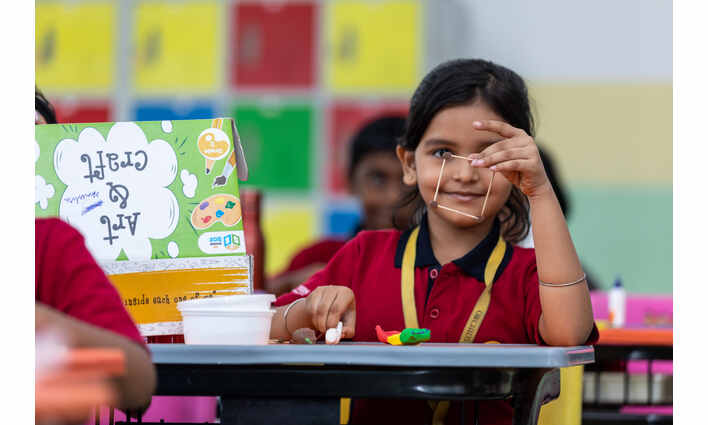Visual Arts for Kids
By Harshitha |
Date 07-08-2024

Table of Contents
Admissions Open for
Visual arts remain an integral part of human culture and expression which leads to the development of creativity. It is an important part of children's well-being and creative ability. These are deep ideas that emerge when children are engaged in visual arts. This article is an in-depth discussion of the integrated world of visual arts for general students, dealing with the concept of visual arts for kids, integration of literature, the benefits of visual arts in learning pursuit, the various experiences in visual arts, right importance of a curriculum rich in visual arts, practical application, and essential materials in clear visual arts learning.

Visual Arts
Understand the concept
Visual art school deals with physical space and a philosophy of art education. This art school provides a set art curriculum in a joyful environment, allowing children to explore multiple art forms and help to improve their artistic skills to bring out creativity, critical thinking, and self-expression through different visual media.
Benefits of Visual Arts for kids
Holistic Development: Visual art education helps one grow both cognitively, emotionally, and concretely in social life. It helps children develop their fine motor skills, perception of spatial awareness, and creative critical thinking.
Skill Acquisition: Through repeated practice, children can further enhance their technical abilities for drawing, painting, sculpting, and most other areas of art production. Such skills mastered in art transfer far into daily problem-solving and critical thinking.
Cultural awareness: Children are made familiar with the different styles of arts that are popular all over the world. As a result, they become aware of different cultures and also realize its importance and its contribution.
Incorporating Visual Arts in Schools
Specific Art Classes: Schools should offer specific art classes that should be held regularly, where children can work hands-on, experiment with materials, and learn about various forms of art.
Integration in other subjects: In the School of Visual arts, the arts concept can be integrated into subjects like history, literature, and science. Such an integration gives a more holistic approach and allows students to understand things visually. For example, students can be explained the historical events or scientific concepts with illustrations. So learning is really engaging and memorable.
Extracurricular Activities: Schools can offer art clubs, exhibitions, and competitions, either to help the children develop or showcase their artistic interests. Additionally, such activities provide an arena for more expression in creativity and acknowledgment of talent.
Literature in Visual Arts for kids
Interrelation
Visual arts and literature have an interrelation and have a close connection, which enriches each other. Stories are always inspired from these works of art while the illustrations always give life to these stories. Adding literature and visual arts together can lead to more understanding and knowledge of an individual.
Art to be Inspired from Literature:
Art Project: Story Based: With the story that a child reads and listens to, they can create certain kinds of art. Later, they can tell the story with the help of the created arts. As for the activity, a child could better visualize and interpret it. This process worked in the material to better understand the text and increased simulated thinking within the child.
Illustrating Books: Children can illustrate scenes from favorite books or create their own stories—illustrated. This weaves literacy skills with artistic expression toward deeper involvement with literature.
Visual Narratives: Showing children how to narrate their concept of telling one's own stories with a sequence of images will develop children's narrative skills and creativity. Children learn to express ideas and feelings in a visual way that complements verbal communication.
School of Visual Arts Supporting Child’s Learning
Cognitive Development
In the school of Visual arts, some activities encourage brain development, which include the improvement in various cognitive abilities. Children start problem-solving, critical thinking, and developing memory while they make art.
Problem-Solving: The need to express ones thoughts through art requires the children to think critically and creatively to master the task similarly. They learn to explore various options and devise ways to solve the art problems.
Critical Thinking: As they analyze and interpret various art pieces, children can learn to think critically. They learn to observe details, show the relationship, and put their thoughts and opinions into words.
Memory: Remembering details about application, material, and procedure for art projects sharpens the memory of children's detail and can be transferred to other academic disciplines.
Emotional and Social Development
Self-expression: Visual arts are a means for children to express their thoughts, emotions, and life experiences, which is very important for emotional and mental well-being.
Confidence: Being able to finish off art projects and receiving a good response against it builds up the self-esteem and confidence of the children. They learn to respect their works and get to self-satisfaction.
Collaboration: Group art projects let children learn to work collaboratively, share ideas, and communicate effectively. These collaborative experiences have the impact of building team spirit and social skills.
Academic Benefits
Improved Concentration: Art requires parting concentration and attention to detail, thus letting an individual develop a sense of focus and discipline. This will also help them in their later academic performance in various subjects.
Enhanced Performance: Several research studies support the fact that arts education leads to improved academic performance. If students are inclined toward the visual arts, they may perform comparatively better in other domains, such as mathematics, reading, and science.
Cross-domain Learning: In other words, the school of visual arts can be easily utilized to teach and reiterate the concepts of different subjects. For instance, they can picture 3D models to learn geometric shapes or draw biological processes to pave the way for a drastically more interactive and engrossing learning experience.
Visual Arts Experiences
Types of Experiences
A diverse experience of visual arts is provided that caters to student interests or learning differences. It includes hands-on and observational activities by which students are drawn into the experience and appreciation of the arts.
Hands-On Activities: Drawing, painting, sculpture, and printmaking; construction is all material and process through which the child may experience. Through these manipulative or hands-on activities, children internalize their experiences and begin creative development.
Field Trips: Visiting museum spaces, art galleries, and artist studios exposes children to professional works and creative spaces. These field trips result in the development of their knowledge in the history of visual arts.
Guest Artists: Inviting a professional artist to be a part of the workshop or lecture can be very motivational for children. They get inspired and motivated by him, learning about various careers in art and ways to make art, hence pushing them towards their own desire and interest in the field of art.
Community Projects: Community art projects, such as mural painting or other public art displays, engage children in the community and convey a sense of belonging and social responsibility. These serve to teach children the value of collaboration in contributing to community well-being.
Design Engaging Experiences
Variety: The provision for a variety of activities gives the children a delightful experience in the activities they are good at and it keeps them more engaged and excited about learning. Variety gives a broader experience to boost their overall performance.
Involvement: Assuming the art children get into active participation and express themselves on art projects, they would be more involved in their work. They will start feeling responsible for their creations and establish a better relationship with the subject.
Relevance: Connecting the art projects to the lives of the children. Assuming the children realize the relevance of the art to personal experiences, they would engage and persevere in their artwork.
Rich Visual Arts Curriculum
Core Elements: A rich curriculum in the school of visual arts would encompass different forms of art, art history, art criticism, and creative products; provide a diversified education including technical skills and critical thinking.
Diverse Forms of Art: There should be several forms ranging from drawing, painting, sculpture, printmaking, and digital art to be taught. Exposure to multiple media and techniques allows the children to explore and discover their inclinations and strengths.
Art History: By teaching children about artists, movements, and culture, students learn about the progress of art through the ages and its significance in society in general. Art History is often paralleled in class with an interactive, hands-on activity.
Art Criticism: By developing the skill of analyzing and critique, the students will ultimately be learning how to become huge critical thinkers and aesthetically judgmental. Students learn to describe what they see, think, in a way that will bring about a greater appreciation for art.
Creative Projects: Original creation and experimentation are one of the most important ways of developing creativity. The curriculum shall have a number of open-ended projects through which children can exercise free thought in the expression of their ideas.
Curriculum Design
Age Appropriate: Teaching different age levels can be catered to through different content and activities, therefore making it accessible and comprehensible to the student. Basically, younger children will focus more on basic techniques and simple projects, while older students will be exposed to more challenging concepts and skills matched with projects at that level.
Progressive Process: Skill development from step one to a higher level, in a progressive manner, inculcates within the child confidence and competence. Each level of learning should be loci: one should build over the other from the foundation to a clear path of artistic growth.
Integration: Integration of visual arts with other units and life situations makes learning more relevant and holistic. For example, linking art projects with science topics, history, or literature helps one get a learning experience in other subjects.
Assessment
Portfolio Development: Comprehensive assessment is done for the collection of work to assess the progress made by the child. Records of development of the child and his artistic accomplishments will be established through portfolios.
Reflection: When students are encouraged to reflect on a process or product, the need to sharpen self-awareness and critical thinking is nurtured. Such practice brings new learning about one's artistic journey and ways to improve.
Feedback and Improvement: Constructive feedback is one of the ways to promote growth. The teacher should offer specific, positive, and improving feedback that will help children work on the development of their skill and knowledge.
Visual Arts in Practice
Classroom Strategies
-
Flexible Spaces: Arranging the classroom to facilitate different types of art activities is crucial for creating an effective learning environment. Flexible spaces allow for individual work, group projects, and the use of various materials and tools.
-
Access to Materials: Ensuring a variety of art supplies are readily available encourages exploration and creativity. Children should have easy access to drawing tools, paints, clay, and other materials needed for their projects.
-
Student-Centered Approach: Allowing students to take the lead in their art projects fosters independence and personal expression. Teachers should provide guidance and support while encouraging children to pursue their ideas and interests.
Integrating Technology
-
Digital Art: Using software and apps for drawing, painting, and animation introduces children to modern art-making techniques. Digital art tools can expand their creative possibilities and prepare them for future technological advancements.
-
Online Resources: Accessing tutorials, virtual museum tours, and artist talks enhances learning opportunities. Online resources provide additional inspiration and knowledge, complementing classroom instruction.
-
Interactive Whiteboards: For collaborative projects and presentations, interactive whiteboards can be valuable tools. They allow students to work together on digital canvases and share their work with the class.
Examples of Successful Programs
Art Buddies
Pairing younger and older students for mentorship in art fosters a supportive learning environment. Older students can share their knowledge and skills, while younger students benefit from personalized guidance and inspiration.
Community Art Projects
Involving students in creating public artworks, such as murals or sculptures, enhances their sense of community and civic responsibility. These projects provide opportunities for collaborative learning and public engagement.
Art and Science Integration
Projects that explore scientific concepts through art, such as creating models of the solar system or illustrating biological processes, make learning more interdisciplinary and engaging. This approach helps students see the connections between different subjects and fosters a holistic understanding of knowledge.
Materials for the Visual Arts
Basic Supplies
Drawing: Drawing paper, professional pencils, erasers, markers, crayons, and many types of paper for various types of surfaces will give students a basic palette of how to learn lines, shapes, designs, and textures.
Painting: Watercolors, temperas, both tubes and block forms, paint brushes, trays for mixing, and canvases are basic things students need for painting. Different types of paints and surfaces offer various possibilities for expression and technique.
Sculpture: Sculpture materials, such as clay, modeling tools, wire, and wood, empower children to create 3-D artwork. Sculpting supports spatial thinking and fine motor development.
Advanced and Specialized Materials
Printmaking: Printmaking materials, such as ink, brayers, carving tools, and printmaking paper, empower children to create prints. Printmaking can be a really satisfying and hands-on process because children love the exploration and accuracy that goes into making a mark on paper.
Digital Art Tools: The use of tablets, styluses, and graphic design software opens access for children to many modern techniques for art-making. This allows them to develop their creative exploration.
Mixed Media: The use of various materials by children in crafting is an exercise for their creativity and resourcefulness. Mixed media allows for lots of different textures, colors, and forms, which might open up a new modality of expression. Safety and Maintenance
Non-Toxic Materials: The safety of every material for children is prime. Non-toxic paint, adhesive, and all other materials make the unit safe when a child is inking his or her imagination.
Proper Storage: Organizing of materials to avoid damage and to ensure easy access is taken into consideration for the maintenance of a functional art space. Proper storage solutions like labeled bins and shelving help you maintain an orderly classroom and better material conditions.
Cleaning-Up Procedures: Teaching the kids how to clean up the place of work and take care of the tools instills in them a sense of responsibility and respect toward the environment. Clearly establishing procedures for cleaning up will guarantee that the materials are kept in good order and ready for their next use.
Conclusion
The visual arts play a huge role in the general upbringing of a child. They enhance development creatively, cognitively, and emotionally but also allow self-expression as a channel for learning. A Welcoming School, as it pertains to the School of Visual Arts, brings together literature, rich experiences, a comprehensive curriculum, classroom strategies, and proper materials, thereby allowing a supportive environment for young artists.
Investment in arts education enriches the life of children and forms the basis of the development of creative-thinking, problem-solving, and innovative individuals in later years. The argument goes that visual arts do not just serve purposes within the school walls but extend over a number of opportunities in a child's outlook towards life. Every child has a right to recognize and find opportunity for himself in visual arts as ways of education and development.
FAQs (Frequently Asked Questions)
What is the key difference between Visual and Performing Arts?
Visual Arts is a form of expressing feelings and emotions through visual means, like painting, drawing, graphics, sculpting, photography etc. Performing Arts is a form of expressing feelings and emotions through a performance like Acting in a theater, a dance and a musical concert, magic etc.
What is a Bachelor of Visual Arts?
Bachelor of Visual Arts, also known as BVA, is a 4-year duration Arts Course in which a student can specialize in any one of the arts of their interest. Depending upon the candidate’s passion, they can choose painting, sculpture, photography, film-production etc.
What are some examples of Visual Arts?
Visual Arts is an extensive field that includes Advertisements, Sculpture, Cartoons, attractive Toys, Ceramics, Architecture, Portraits etc.
What is Visual Art graphics?
Visual art graphics is a designing technique used by a creative person to give an appealing form to an object. It includes engraving, woodcutting, optimizing, imaging, coloring, shaping, printmaking etc.
Liked what you read? Feel free to share this article with your friends and spread the knowledge!
Related blogs:
Arts and Crafts Activities for Different Seasons: Discover seasonal arts and crafts projects with us.
Art Therapy for Children: Find out the benefits of art therapy for emotional growth.
Theatre & role-playing games: Develop creativity and skills by engaging in theater and role-playing activities.
CBSE Schools In Popular Cities
- CBSE Schools in Bangalore
- CBSE Schools in Mumbai
- CBSE Schools in Pune
- CBSE Schools in Hyderabad
- CBSE Schools in Chennai
- CBSE Schools in Gurgaon
- CBSE Schools in Kolkata
- CBSE Schools in Indore
- CBSE Schools in Sonipat
- CBSE Schools in Delhi
- CBSE Schools in Rohtak
- CBSE Schools in Bhopal
- CBSE Schools in Aurangabad
- CBSE Schools in Jabalpur
- CBSE Schools in Jaipur
- CBSE Schools in Jodhpur
- CBSE Schools in Nagpur
- CBSE Schools in Ahmednagar
- CBSE School In Tumkur

Call Us to know more about Orchids
Swipe Up
















